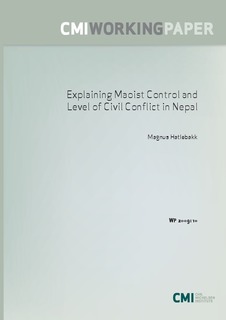Explaining Maoist control and level of civil conflict in Nepal
| dc.contributor.author | Hatlebakk, Magnus | |
| dc.date.accessioned | 2009-11-23T12:15:54Z | |
| dc.date.accessioned | 2017-03-29T09:13:12Z | |
| dc.date.available | 2009-11-23T12:15:54Z | |
| dc.date.available | 2017-03-29T09:13:12Z | |
| dc.date.issued | 2009 | |
| dc.identifier.isbn | 978-82-8062-376-8 | |
| dc.identifier.issn | 1890-5048 | |
| dc.identifier.uri | http://hdl.handle.net/11250/2436059 | |
| dc.description.abstract | Does poverty or inequality explain the Maoist insurgency in Nepal? In contrast to previous studies we limit the analysis to the hill/mountain districts of Nepal as very few terai (plains) districts are classified as Maoist. And we conduct separate analyses for Maoist control and level of conflict. We find that income poverty and land-inequality are main determinants of Maoist influence, while the less visible income inequality is not so important. We also demonstrate that previous findings by Murshed and Gates (2005), where landlessness appears to be important, are due to two outliers that are the core Maoist districts. Without the outliers landlessness is negatively, and not positively, correlated with Maoist influence. | |
| dc.language.iso | eng | |
| dc.publisher | Chr. Michelsen Institute | |
| dc.relation.ispartofseries | CMI Working paper | |
| dc.relation.ispartofseries | WP 2009: 10 | |
| dc.subject | Civil war | |
| dc.subject | Data issues | |
| dc.subject | Nepal | |
| dc.subject | Jel codes: | |
| dc.subject | D74 | |
| dc.subject | I32 | |
| dc.title | Explaining Maoist control and level of civil conflict in Nepal | |
| dc.type | Working paper |
Tilhørende fil(er)
Denne innførselen finnes i følgende samling(er)
-
Bora-import [434]
